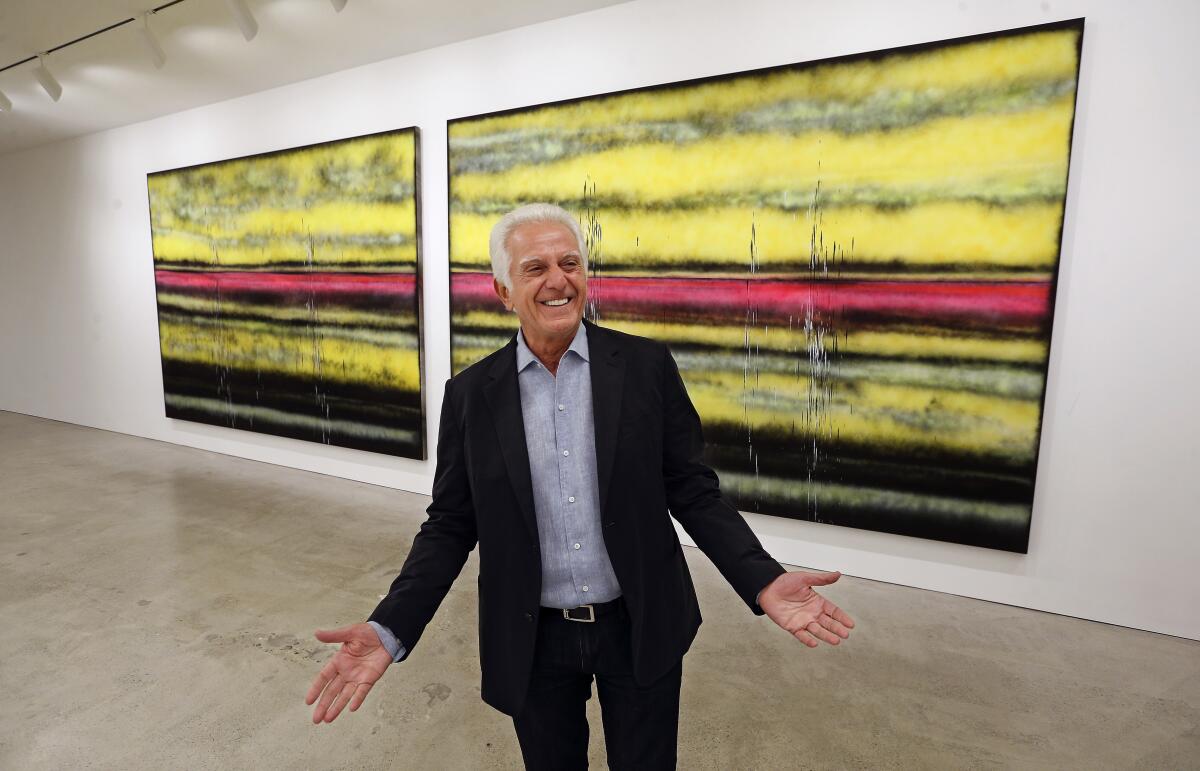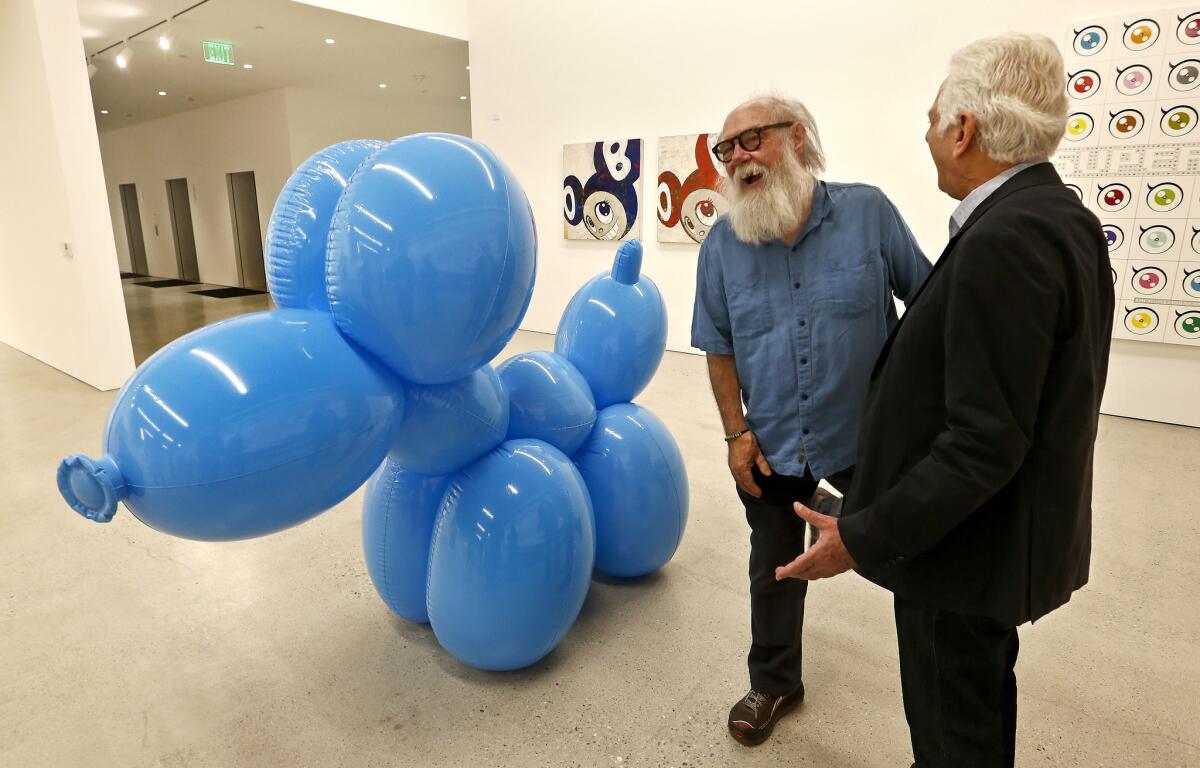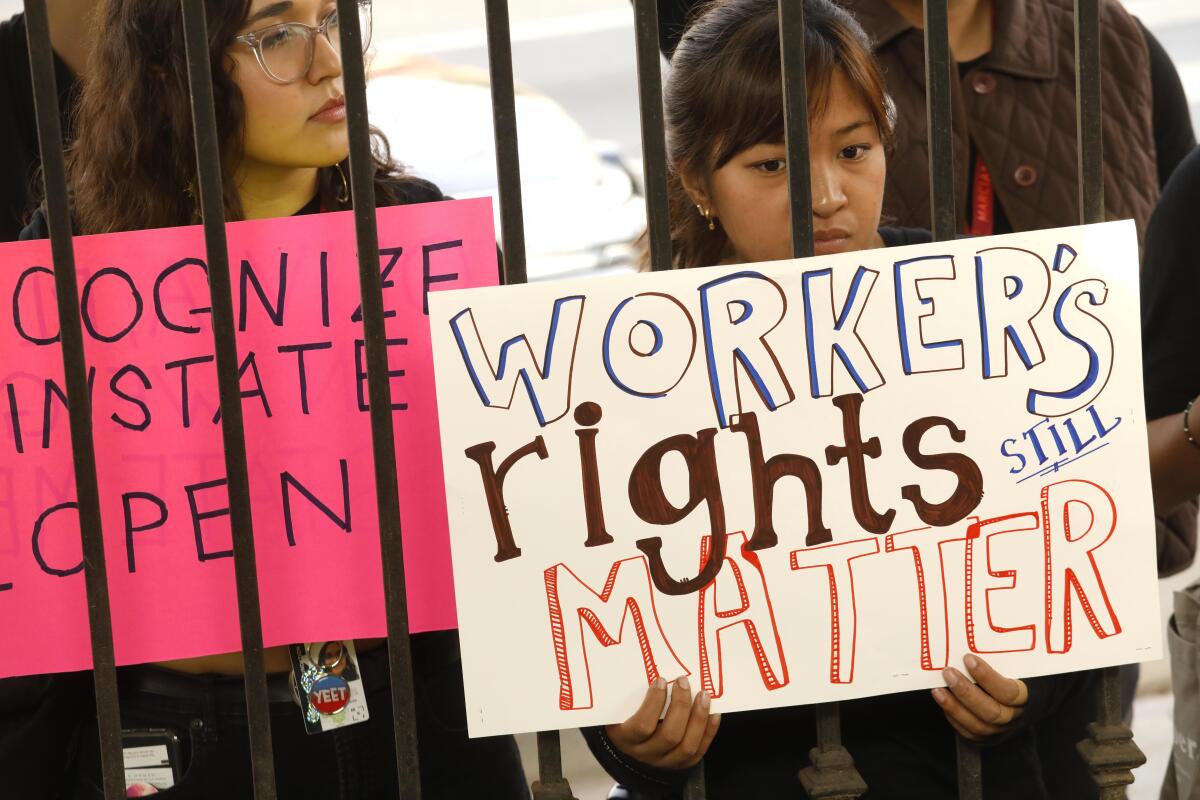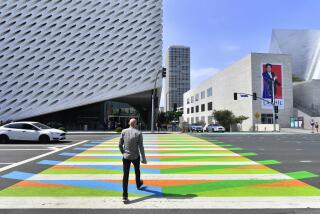Inside the Marciano Art Foundation’s spectacular shutdown

In spring 2017, 600 members of the glitterati gathered inside the converted Masonic temple near Koreatown to celebrate the opening of the Marciano Art Foundation, the swank new home for the private collection of Guess Inc. co-founders Maurice and Paul Marciano.
Guests from the worlds of Hollywood (Sharon Stone), politics (Mayor Eric Garcetti), philanthropy (Eli Broad) and art (Takashi Murakami) strolled through the 110,000-square-foot space. On view: 114 works from 47 artists culled from the brothers’ 1,500 paintings, sculptures, drawings, photographs, videos, prints and installations. As guests mingled, the loading dock gate opened onto the parking lot, temporarily transformed into a sumptuous garden where a feast was catered by Wolfgang Puck.
The new foundation, part of the growing pack of private museums established by ultra-wealthy art collectors, signaled that the Marcianos had reached the pinnacle of power and prestige among the city’s cultural elite. Jeffrey Deitch, the art dealer and former director of the L.A. Museum of Contemporary Art, had predicted to the New York Times: “I think this will become one of the most important spaces for contemporary art in the whole country.”
Alas, it was not to be. Last November, just two and half years after opening, the Marcianos shocked the city and the art establishment by abruptly closing their new showpiece. The brothers blamed low attendance, but others linked the announcement to an internal labor dispute. Just one day earlier, the foundation laid off about 70 employees who were attempting to unionize.
In interviews with The Times, nearly two dozen people involved with the Marcianos or familiar with their art collection and their other enterprises over the years said the closure was more complicated. They paint a knotty portrait of troubles at the foundation from the beginning, citing a lack of organizational structure and long-term planning that girds cultural institutions for the long haul.
The demise of the Marciano Art Foundation not only underscores growing tensions between art patrons and art workers but also raises questions about the public benefit of private museums run by wealthy art collectors as foundations. Such establishments, often viewed by skeptics as vanity projects or tax shelters, have mushroomed in recent years.
A representative for the foundation and for Maurice Marciano, long seen as the driving force behind the foundation, declined to respond to multiple Times requests for an interview, saying Marciano was traveling and unavailable for comment. The Marcianos also did not respond to an emailed list of questions.
The sudden closure of the foundation also cast a spotlight on the Marciano brothers. With Guess, the Marcianos leveraged sexy, stone-washed jeans into fabulous wealth and social clout. In the Los Angeles circles in which they ran, they inspired both admiration and fear.
Many sources connected to the Marciano Art Foundation and other Marciano projects declined to be named, saying they were scared of retaliation. They described the art foundation as a case of good intentions derailed by ambition, shortsightedness, capriciousness and ego. Even before employees pushed to unionize, sources said, Maurice Marciano may have been looking for an out. As one longtime Los Angeles art world executive said of the unexpected closing, “The unionization is only half of the story.”
Said Miami-based art advisor Karen Boyer, “To close down a museum that they had spent so much time and money on and that had both permanent and temporary exhibitions is very strange.”
The mystery remained: Why?
::
Maurice, 72, and Paul Marciano, 68, who founded Guess with brothers Georges and Armand, began collecting in the 1980s. Initially their tastes ran to established trophy artists such as Roy Lichtenstein and Jean-Michel Basquiat. By the 2000s, collecting the work of edgy new artists animated them. They bought pieces by Mark Grotjahn and Sterling Ruby; they championed emerging artists like Analia Saban. By all accounts, Maurice took the lead in acquisitions. He cultivated relationships with artists, frequently visiting their studios and galleries.
As Maurice’s collection expanded, so did his role in the city’s art community. In 2014 he became co-chairman of the board at the Museum of Contemporary Art. One person familiar with the board’s dynamics called him one of the top three or four most generous patrons in L.A. His $20-million gift pledged in 2013 to MOCA helped to rescue the troubled museum.
In 2012 the brothers established the Maurice and Paul Marciano Art Foundation. A year later, they purchased the former Scottish Rite Masonic Temple on Wilshire Boulevard for $8 million and hired architect Kulapat Yantrasast to refurbish the building, vacant since 1994.
In the buzzy run-up to the foundation’s opening, Maurice Marciano told The Times: “We just wanted to share our collection and passion for art with the public.”

Although described as a joint enterprise between the brothers, the art foundation was Maurice’s project. One person who worked directly with the brothers said Paul, who remained chief executive of Guess (Maurice retired from the company in 2012), did not want to establish the nonprofit and thought buying the temple was excessive. Still, he supported Maurice.
Contemporary art was booming. According to figures compiled by Art Basel and UBS, global art market sales were estimated at $56.6 billion annually by the time the Marciano Art Foundation opened. As more money sloshed around in that market, more collectors began to establish private museums to exhibit their acquisitions. In 2016 the art-collector database Larry’s List and art marketing operation AMMA reported the existence of 317 such museums around the world, 70% of which had been founded since 2000.
Collectors could reap substantial tax breaks on their acquisitions and shift the burden of maintaining them by donating the art to a nonprofit foundation, while still retaining control over the works. The phenomenon has left skeptics wondering whether these organizations deliver a real public good, as nonprofits are expected to do. In 2016, after the Senate Finance Committee looked at the question, Chairman Orrin Hatch wrote in a letter: “Despite the good work that is being done by many private museums, I remain concerned that this area of our tax code is ripe for exploitation.”
“The core issue is what’s the educational value — that’s why there’s a beneficial tax code,” said Tom Eccles, executive director of the Center for Curatorial Studies at Bard College in Annandale-on-Hudson, N.Y. “Just putting art on the wall in a building you own does not rise to the standard of a tax deduction.”
Photographer Carolyn Cole captures the styles and personalities at Frieze Los Angeles, which for some is like cosplay for the blue-chip art world.
In the Marcianos’ case, Maurice and Paul did not establish the art space for the tax break, according to a source familiar with the inner workings of the foundation. The brothers wanted control and flexibility over the use of their collection, so they loaned their art to the nonprofit rather than donating it.
The Marcianos’ foundation does own the refurbished temple, however, raising potential questions about its tax-exempt status, and the status of art purchased by the foundation specifically for the building, such as the Alex Israel wall mural “Valet Parking,” a fixture of the interior. Currently shuttered, the structure provides no evident public benefit, and the brothers have not said what they intend to do with the property or how it might be used in the future.
Unlike many nonprofit cultural institutions, the Marcianos did not install an outside board of directors or establish an endowment. In 2016, Maurice hired as artistic director his daughter Olivia, 27, whose resume included working at a New York art gallery. The foundation outsourced its educational programs and functioned with a small full-time staff. Seventy part-time visitor service associates who worked as docents, ticket takers and the like were paid L.A.’s minimum wage, currently $14.25 an hour.
In contrast, the 5-year-old Broad museum in downtown L.A., established by Eli and Edythe Broad, created a board of directors, has a permanent chief curator and pledged to create an endowment in excess of $200 million.
The Marciano foundation mounted solo exhibitions by Ai Weiwei, Olafur Eliasson and Donna Huanca and others without hiring a permanent curator. Philipp Kaiser, former director of Germany’s Museum Ludwig and former MOCA curator, guest curated the inaugural exhibitions. He described Maurice as hands on and open to ideas.
“He encouraged me. He gave me a lot of freedom,” Kaiser said. But he added: “It is challenging to run a large institution without a chief curator or director who coins a very specific artistic idea. If you only work with guest curators, the mission can be easily too convoluted.”
Overall, sources said, capriciousness ruled an enterprise that didn’t prioritize long-term thinking or analysis.

::
The Marciano brothers and their sister, Jacqueline, were born in Algeria and Morocco but grew up in Marseilles, France, descendants of three generations of Orthodox rabbis.
The brothers got their start selling and manufacturing ties on the Cote d’Azur, eventually owning a clutch of clothing stores. Georges and Maurice came to Los Angeles on holiday in the late 1970s, fell in love with the city and stayed. Paul and Armand followed later. They opened a shop in Century City called MGA, after three of their first initials.
It was Georges who came up with the name Guess and the design behind the Marilyn, a sexy, form-fitting stone-washed three-zipper pair of jeans. Priced at a then-unheard of $60, the Marilyn was a massive hit. In one year, the company racked up $6 million in sales. Soon the Marcianos were licensing everything from sunglasses to bedsheets.
The brothers, who had shared a cot in their Marseilles kitchen, remained uncommonly tight. They lived and worked together. Paul created the distinctive advertising, launching the careers of Claudia Schiffer and Anna Nicole Smith. “No matter what you do, tastes and fashions change,” he told Wine Spectator magazine. “But the public will remember a face.”
The Marcianos were known to be charming, impulsive, volatile and blunt. Cinzia Simone, who worked at the company for 12 years as a designer and later design director, said it wasn’t for everyone.
“I loved it. I learned a lot,” she said. “They were tough, but that business is not easy. Most people didn’t understand their way of doing business. If they didn’t like something, they’d tell you and make you feel like you didn’t do well. They are very passionate about what they do. Sometimes passion can come across a little wrong. Most people couldn’t take it and left.”
FRIEZE LOS ANGELES: Complete coverage of the 2020 art fair
Guess went public in 1996, and the brothers would eventually become billionaires. More than an immigrant success story, for a time they were synonymous with the sexy, casual vibe of 1980s L.A. They bought mansions in Beverly Hills within blocks of one another. They were mainstays at Spago, where Puck named a pizza after them. Paul later designed the restaurant’s uniforms.
The Marcianos also became magnets for controversy. For seven years during the 1980s, they battled the Nakash brothers, the family behind Jordache, to whom the Marcianos sold a 51% stake in Guess for $5 million. Before the dispute was finally settled (the Marcianos ultimately retained control of Guess) the parties hurled a list of allegations that prompted a series of federal investigations. For starters, the Marcianos claimed the Nakashes tricked them into the sale and stole designs; the Nakashes alleged the Marcianos secretly diverted funds from the business. “It’s a shame,” Robert Sutcliffe, a lawyer for the Nakashes, said at the time. “With the amount both sides are paying in legal fees they could buy another jeans company.”
In the 1990s Guess faced allegations regarding its labor practices. In 1992, as part of the Department of Labor’s efforts to crack down on abuses in the garment industry, the federal government and Guess reached an agreement in which the apparel maker agreed to inspect its contractors’ workshops regularly, review payroll records and enact other measures to prevent labor law violations. Seven years later, the company agreed to pay $1 million to settle a 1996 lawsuit alleging its contractors failed to pay workers minimum wage or overtime. Under the announced settlement, Guess did not admit to any wrongdoing.
At the turn of the millennium, a protracted lawsuit involved Michel Benasra, a boyhood friend of the Marcianos who held licenses for Guess Home and Baby Guess. Benasra accused the Marcianos of franchise-law violations in their license agreements. The Marcianos, who had terminated his licenses, countered with allegations of mismanagement. He told Forbes, “They don’t just like to win. They like to destroy.” The Marcianos prevailed in arbitration, winning $7.6 million damages for unpaid royalties.
::

Inside the former temple on Wilshire Boulevard, employees said Maurice managed by fiat.
“He was a little guy, but he was very loud and not afraid to yell,” said one individual who described meetings in which full-time staffers kept their heads bowed as Maurice directed his anger.
Adding to the strained environment, workers said, was Maurice’s impulsiveness. One person recalled how exhibition installations would be upended when one of Maurice’s celebrity friends like Leonardo DiCaprio or Haim Saban called for a private tour, triggering demands to expedite the work.
Meanwhile the 70 part-time visitor service associates, or VSAs, began to resent their treatment.
Workers referred to Olivia Marciano as Ivanka because, like President’s Trump daughter, they said, she had been given a huge platform with little experience.
The associates complained that the Marcianos rarely engaged or even made eye contact with them. “There was a pretty stark distinction between people on the floor and people in the office,” said Eli Petzold, a former VSA.
Although the VSAs were guaranteed a minimum two-day workweek, their schedules were frequently toppled at the last minute. Former associate Spencer Longo said if Maurice saw the foundation was sparsely populated with visitors, he would make a snap judgment to reduce their hours.
The foundation would shut down for exhibition installation or deinstallation, and VSAs would be put temporarily out of work without pay for a month with little notice, Longo said.

Then came the allegation of sexual harassment against Paul Marciano.
In January 2018, model Kate Upton tweeted: “It’s disappointing that such an iconic women’s brand @GUESS is still empowering Paul Marciano as their director #metoo.” In an interview with Time magazine she elaborated, saying he had groped and kissed her during the shoot for an ad campaign in 2010. She was 18 at the time and said after she repeatedly rebuffed him, he became hostile, calling her “disgusting” and a “pig.”
Paul Marciano denied the allegations and in a statement called them “preposterous.” “I have never been alone with Kate Upton,” he said. “I have never touched her inappropriately.”
Four other women came forward to accuse Paul Marciano of inappropriate comments, texts and unwanted advances and touching. He stepped down and the company instigated an investigation. In June, Paul announced that he was resigning as executive chairman of Guess Inc.’s board and was replaced temporarily by Maurice. Guess and Paul Marciano settled with Upton and the four women; together they received a total of $500,000.
Inside the Marciano Art Foundation, disquiet was building. Staffers had questions. The Marcianos did not address the allegations. Guess eventually sent talking points if questions arose internally or externally.
Preparations were underway to mount an Ai Weiwei solo show in September. According to a source involved in the show, Maurice was presented with the suggestion that the foundation remove Paul’s name from the invitations. He declined.
The accusations against Paul had other ramifications as the foundation talked to Andrea Bowers about mounting a solo show. Bowers is an L.A.-based artist whose work addresses social issues including women’s rights and climate change.
Bowers proposed “Open Secret,” a large-scale installation documenting the hundreds of men accused of sexual misconduct in the #MeToo era. A smaller iteration had been shown at the Andrew Kreps Gallery in New York.
According to a source familiar with the discussions, Maurice wasn’t interested. “The sentiment was that he didn’t want to bring more attention to his brother and make it more of a topic of a conversation than it was.”
Bowers, who declined to comment to The Times, later showed “Open Secret” at Art Basel last year.
Maurice’s enthusiasm for operating public art exhibitions appeared to wane, sources said. He came into the foundation less. According to someone close to the Marcianos, “I think they saw it as a shiny toy. They wanted to show off their art and have big parties … but I think they stopped caring towards the end of 2018.”
Running a private museum is a complicated, time-consuming and costly venture.
“He didn’t really know how expensive it is to run his own private museum,” said someone involved with Maurice’s art and philanthropies. “He did it in a very generous, very first-class generous way.”
Parties for exhibition openings had open bars and guests were given Uber credits to ferry them to and fro. One person who worked closely with the foundation said the grand opening cost $500,000, and the Ai launch party was close to $100,000.
The foundation’s 2017 tax filing, the most recent publicly available, reported revenue of $14.9 million. Admission to the foundation was free. According to tax documents, the major contributors were Paul and Maurice, the foundation and Jenny Investments, whose address is the same as the Marcianos’ office in Beverly Hills.
Someone who worked closely with Maurice recalled one suggestion to secure corporate sponsorships, but the idea didn’t seem to move forward.
At the same time, employees at the Frye Art Museum in Seattle and the Guggenheim in New York, among others, began a drive to unionize. In February 2019 the Marciano associates, increasingly unhappy with low wages, lack of benefits and a dearth of opportunities to move up in the organization, began their own push to organize.
“When we asked for resources it was pretty impossible to get anything, like more seating in the galleries or water, anything to make the experience better, the answer was it was too expensive or not on budget,” Longo said.
Then in March, Jamie Goldblatt Manné, the foundation’s deputy director who had worked with the Marcianos for 10 years, resigned. She was not replaced, and Olivia Marciano took on more responsibility.
When the foundation shut down in November, many felt blindsided. According to Petzold, future shows were being planned, ticket reservations had been released on email. Shows by Huanca and Anna Uddenberg were cut short. One person who was involved with exhibitions said a phone notification of the closure came just half an hour before the public announcement.
The workers have since filed a complaint with the National Labor Relations Board, alleging that Paul and Maurice Marciano and the foundation engaged in unfair labor practices. A lawsuit seeks class-action status and alleges a violation of the state’s Worker Adjustment and Retraining Notification Act, which requires employers to provide adequate notice before terminating operations and conducting mass layoffs.
A lawyer representing the foundation did not respond to a request for comment. However, the foundation’s legal response to the suit, filed Jan. 31, “deny generally and specifically each and every material allegation contained in the complaint.”
What happens next remains an unanswered question. In theory, the Marcianos could be subject to IRS scrutiny.
“The building is not a charitable act. Simply owning art but not educating the public is not charitable,” said Marcus Owens, a lawyer with Loeb & Loeb in Washington, who was formerly the director of the IRS’ Exempt Organizations Division. “The question is what are the plans to convert the museum? Will it do something to benefit the public?”
Howard Rachofsky, the retired hedge fund manager and co-founder of the Warehouse, a private art space in Dallas displaying his own considerable collection of contemporary art, considers Maurice a good friend. He called the foundation’s demise “disappointing.”
“It will become one less space available for the Los Angeles community and beyond to get to experience contemporary art in a very interesting setting,” he said.
Maxwell Anderson, former director of the Whitney Museum of American Art in New York and the Dallas Museum of Art, is currently president of the Souls Grown Deep Foundation, an Atlanta-based collection of African American art from the Southeast.
“Often these private museums are blue chip collections,” Anderson said, “but they are not pioneers of artistic achievement.” Instead, he said, they mostly serve as “an affirmation of good taste.”
What is undisputed: The temple has once again closed. At the moment it stands over Wilshire Boulevard, a very expensive storage unit.
More to Read
The biggest entertainment stories
Get our big stories about Hollywood, film, television, music, arts, culture and more right in your inbox as soon as they publish.
You may occasionally receive promotional content from the Los Angeles Times.







